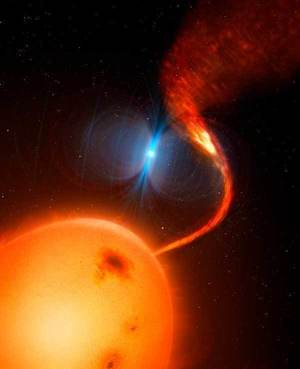| Jun 07, 2021 |
Scientists identify a rare magnetic propeller in a binary star system
|
|
(Nanowerk News) Researchers at the University of Notre Dame have identified the first eclipsing magnetic propeller in a cataclysmic variable star system, according to research forthcoming in the Astrophysical Journal ("Confirmation of a Second Propeller: A High-Inclination Twin of AE Aquarii").
|
|
The star system, referred to as J0240, is only the second of its kind on record. It was identified in 2020 as an unusual cataclysmic variable — a binary system consisting of a white dwarf star and a mass-donating red star. Normally, the compact white dwarf star collects the donated gas and grows in mass. In J0240, however, the fast-spinning, magnetic white dwarf rejects the donor’s gas and propels it out of the binary system.
|
 |
| An illustration of a fast-spinning, magnetic white dwarf rejecting the donor gas in the cataclysmic variable known as J0240. (Image: Dr. Mark Garlick)
|
|
“It takes a rapidly spinning dwarf with a strong magnetic field in order to create a propeller,” said Peter Garnavich, professor of astrophysics and cosmology physics and chair of the Department of Physics at Notre Dame, and lead author of the study that presented evidence of the propeller system. “Normally, gas coming off of the donor star will land on the white dwarf. That’s as common as sand on a beach. But in a magnetic propeller, the gas is ejected from the binary in a wide spiral pattern — like a lawn sprinkler watering your yard.”
|
|
White dwarfs are the dense remnants of low-mass stars like our sun, which scientists say will evolve into a white dwarf in another five billion years or so. Without a companion star, however, the sun will never be part of a cataclysmic variable system.
|
|
The only other cataclysmic variable similar to J0240 is AE Aquarii, a binary star system known since the 1950s and believed to also be a magnetic propeller system. Conversely, J0240 is observed close to the binary orbital plane, meaning that the gas ejected from the system is seen silhouetted against the light of the stars. This is the first direct evidence that a magnetic propeller ejects the red star’s donated gas.
|
|
“What’s unique about the system is that we actually can see blobs of gas as they’re ejected by the propeller,” Garnavich said. “That gas is blocking some of the light from both stars and we can directly see that absorption in our data.”
|
|
Garnavich’s team began observations at the Large Binocular Telescope in Safford, Arizona, where the researchers were able to record the occurrence of flares and eclipses that illustrated the rapid spinning of the white dwarf star, and the pull of the magnetic field — which expels incoming gases that would otherwise be added to the star but instead creates a spiral of gas expanding away from the two stars.
|
|
“The more we observed the star, the more exciting it appeared,” said Garnavich. The team gathered observations in September, October and November of 2020. Data gathered in September captured the first half of J0240’s orbit. In October, the team captured the second half.
|
|
“The flares we see are mini-explosions that blow off gas at 6 million miles per hour, or 1 percent of the speed of light,” he said.
|
|
The flaring disappears when the red companion gets in the way during an eclipse. From the timing of the eclipses, the team was able to pinpoint the location of the flares. “The flaring is coming from very close to the compact companion, likely from the whack the gas receives as it approaches the rapidly spinning magnetic field,” Garnavich said.
|
|
Garnavich hopes to learn a lot more from the J0240 binary from further observations. One of the big unknowns is the white dwarf spin period, which the team was unable to detect. “The energy of the propeller is coming from the spinning white dwarf, so we expect the spin rate to be slowing over time. When it runs down, the propeller will stop and the system will look like a ordinary cataclysmic variable,” said Garnavich.
|
|
“The biggest question is exactly how do you get into this state,” he said. “It’s a very short-lived phase where you have a magnetic white dwarf spinning about as fast as it can spin without actually flying apart. Spinning so fast with a strong magnetic field — seems like it can’t be just coincidence.”
|

